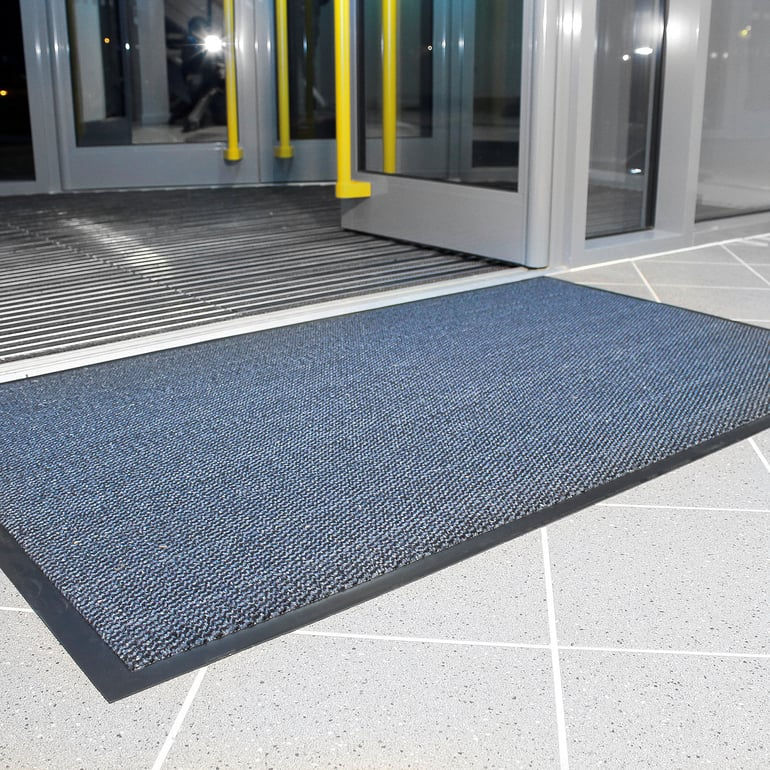Eco-Friendly Entrance Door Mats for Sustainable Homes
- Floor Safety Store

- Nov 13
- 3 min read
As sustainability has evolved from being just a buzzword, many facets of home design and décor are reconsidered from an environmentally conscious standpoint. One of the most underrated yet vital areas of the home is the mainstay of the home, Entrance Mats. Although an item of minor significance, a sustainable entrance doormat is a surprisingly impactful element in the process of developing a sustainable home. In addition to protecting the indoor environment and keeping floors clean, eco-friendly entrance door mats also have the potential to eliminate waste, promote the use of recyclable materials, and reduce toxins for better indoor air quality.
The Value of Sustainable Choices in our Day-to-day Life
Awareness regarding climate change, pollution, and environmental degradation is increasing. Thus, homeowners are conscious about which materials, linens, and products to bring into their physical environment. From countertops made of recycled material to solar-powered tubes, sustainability has made its way into nearly every aspect of home design. Even the entrance into the home, often a representation of first impressions:
An eco-friendly entrance doormat is not just an aesthetic accent piece. It serves as the first line of defense against dirt, moisture, and contaminants being tracked into the home. When contaminants are kept from coming into the home, chemical cleaning products can be minimized, and unnecessary water use is reduced because of dirt and moisture tracking. This simple function can help to reduce environmental footprints while achieving a cleaner, healthier home.
The most eco-friendly portion of an eco-friendly mat is the material used to create it. Eco-friendly mats are often made from renewable, biodegradable, or recycled materials instead of synthetic mats made from PVC, nylon, or polyester synthetic mats can take hundreds of years to break down as they are made from newsprint and other petroleum-based components. While many sustainable materials exist, below are some of the mat materials that are anecdotally found to be more sustainable than others:
Coir (Coconut Fiber): Coir is one of the most common materials for eco-friendly mats. Coir is made from the husk of coconuts and is a natural fiber that is durable, coarse, and great for scraping mud and debris off shoes. Coir Entrance Floor Mats are completely compostable and biodegradable and, therefore, are a great option for homeowners who prefer a more natural-looking fiber. Also, because coconuts are a renewable resource, mats made of coir support sustainable agricultural practices.
Recycled Rubber: Rubber Entrance Floor Mats made from recycled rubber are also a great eco-friendly option! These mats are generally made with old tires or other industrial rubber waste that would typically go into landfills and provide a durable, slip-resistant mat that has excellent performance in a high-traffic area. Additionally, recycled rubber mats are weatherproof and durable, providing sustainability with both a reused product and durability.
Jute and Sisal: Plant-based fibers, such as jute and sisal, are biodegradable and come from sustainable crops. They give an entrance space a natural, rustic feeling. These materials are best for covered entrances where they are protected against excessive moisture. Jute and sisal mats can be dyed with non-toxic, plant-based dyes to keep the product eco-friendly!
Bamboo: Bamboo is a popular material for sustainable products because it grows quickly and doesn't require excessive pesticides or fertilizers. Bamboo doormats are lightweight, beautiful, and durable. The smooth wooden slats of the mats are appropriate for indoor and semi-outdoor use while providing a clean look and minimal environmental footprint.
Recycled Fabric or Plastic: Certain environmentally responsible mats are made using recycled fabrics, utilized fishing nets, or plastic bottles (PET). They actively divert plastic waste from our oceans and landfills. Recycled materials allow us to produce pleasing, resilient, and soft mats that perform comparably to synthetic mats without causing further environmental damage.
Environmental and Health Benefits: Eco-safe entrance mats successfully achieve sustainability through many different meaningful strategies beyond just the materials used:
Waste Reduction and Pollution Control
There is a reduction in landfill waste associated with the use of recycled or biodegradable materials in eco-safe entrance mats. There is also a reduction in pollution caused by the use of virgin plastics or synthetic fibers. Producing synthetic materials generally consumes large-scale energy and emits greenhouse gases.
Supporting the Use of Renewable Resources: Fabrics like coir, jute, and bamboo are renewable and produced in a way that is beneficial for rural economies. This placement is reducing our reliance on non-renewable products, particularly petroleum-based synthetic products, which helps in achieving a circular economy.
Less Use of Maintenance and Chemicals: Due to the ability of environmentally friendly Entrance Door Mats to trap dust and dirt deposits, you will not have to mop or vacuum as often. While you are not much away from wheat or knowing cleaner, it will lead to fewer overall chemicals released into the environment, which may be harmful to you or others.






Comments